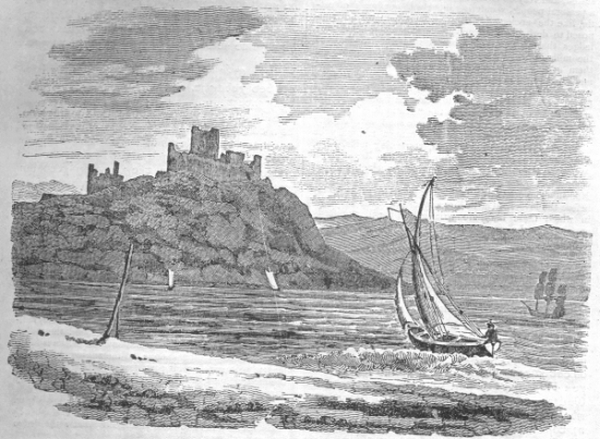Dundrum Castle, County of Down
From the Dublin Penny Journal, Volume 1, Number 36, March 2, 1833

DUNDRUM CASTLE.
The prefixed illustration,--which is engraved from an original drawing by Alexander Johns, Esq. of Carrickfergus, and kindly given to our Journal,--will convey a good idea of the bold and picturesque situation of one of the finest castles erected by the first Anglo-Norman settlers in Ulster. It stands on a high rock, which commands an extensive and varied prospect of Dundrum bay, the sea to the south, a great part of Lecale to the east, and of the noble range of the Mourne mountains to the south and south west.
Dundrum Castle is usually supposed to have been erected for the Knights Templars by the renowned Sir John de Courcey, and that powerful body possessed it till the abolition of the order in the year 1313. It was afterwards granted to the Prior of Down, who held it, with a small manor adjoining, till the final suppression of religious houses; and the reversion of this house and manor, with the yearly rent of 6l. 13s. 4d. reserved out of it, was granted to Gerald, Earl of Kildare.
The Castle, with seven townlands adjoining it, became the property of the Magennis's, the ancient Irish proprietors of the surrounding country, and after their forfeiture, it came into the possession of Lord Cromwell of Oakham, whose son, Thomas, Viscount Ardglas, sold the same to Sir Francis Blundell, from whom it descended by marriage to the present owner, the Marquess of Downshire.
"When the castle," says Harris, "was in repair, it often proved a good guard to this pass, and as often an offensive neighbour to the English planted in Lecale, according to the hands that possessed it. Anno 1517, Gerald, the ninth Earl of Kildare, then Lord Deputy, marched into Lecale, and took it by storm, it being garrisoned at that time by the Irish, who had drove out the English some time before. It was again possessed and repaired by the Magennis's, and retaken by the Lord Deputy Gray, with seven castles more in Lecale, Anno 1538. It afterwards got into the hands of Phelim M'Ever Magenis, who was obliged to yield it to the Lord Mountjoy in the year 1601. The loss of this fortress appears to have intimidated the other branches of this family, as soon after we find Arthur, chief of the sept of the Maginnisis, making his submission on his knees to the Lord Deputy at Drogheda; and about the same time Rory Oge Maginnis also submitted.
About 1652, the castle was finally dismantled by order of Cromwell, since which time the walls have been slowly mouldering to decay.
Harris adds, that "there is no Inscription on it to discover the founder, or the time when it was erected," but the style of its architecture sufficiently points out the era, of its foundation, and corroborates the general traditions which ascribes it to the conqueror of Ulster, as de Courcey is usually called. The ruins consist of a great circular keep or tower, surrounded by fragments of smaller towers and other outer works, of which the barbican is the most striking and picturesque object. To the south of the castle there are ruins of a larger mansion or dwelling house, of the style of domestic architecture usual in the sixteenth century.
S. M'S.
Carrickfergus.
